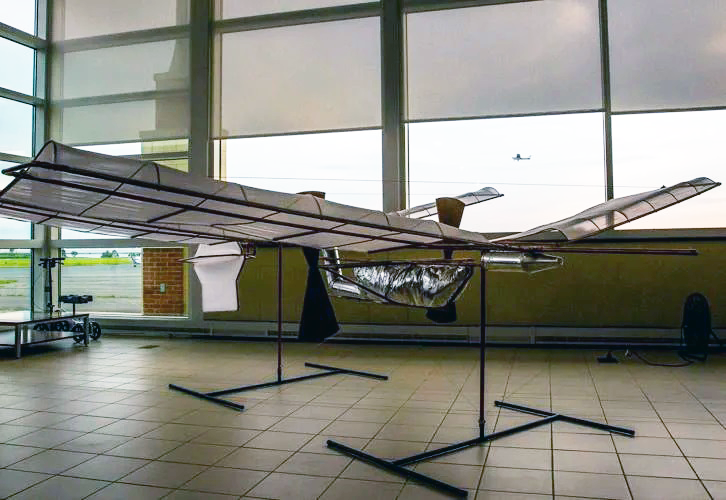GROUP SEEKS TO BUILD REPLICA OF LANGLEY AIRCRAFT
Stafford ceremony recalls aviation's first unmanned flight, building of Aerodrome No. 5
By: James Scott Baron
Source: The Free Lance-Star, Fredericksburg, Va.
August 26, 2022
Fans of history and aviation gathered Thursday to celebrate the first unmanned, sustained flight, which took place in Stafford County just over 126 years ago.
“It’s a neat story that hasn’t been told well enough for people to really recognize it,” said David James of Fredericksburg. “Having a replica and having it on display and letting people know it was part of the way forward towards flight is kind of neat.”
Guest speaker Paul Glenshaw, an independent filmmaker, artist and writer, said back in the late 1880s, Samuel Pierpont Langley turned the Smithsonian castle into the Defense Advanced Research Projects Agency of its day.
“This is cutting edge thought and experiment,” Glenshaw said. “Trying to figure out what an airplane might be, a mechanical flying machine.”
The ceremony, held at Stafford Regional Airport, was hosted by members of the Langley Flight Foundation to commemorate Langley’s historic flight in Stafford on May 6, 1896. On that day, 62-year-old Langley successfully flew his unmanned, steam-powered Aerodrome No. 5 over the Potomac River near Chopawamsic Island. Historians at the Smithsonian say during the flight, Langley’s 30-pound aircraft “flew three circles to the left and climbed about 60 feet” before touching down in the Potomac.
Paul Glenshaw of Glenshaw Creative speaking at the Langley Flight Foundation event on August 25, 2022 (Photo by Tristan Lorei, Free Lance Star)
Ray Sami, Jr., whose father owns the 13-acre Chopawamsic Island, believes Langley’s achievements do not get the accolades they deserve.
“This is a lost piece of Americana,” Sami said. “When we’re talking about the Wright Brothers, this should be on par, if not maybe even above, because this precedes them. This is something that should be elevated to that level.”
Langley’s historic flight, and other previous flights by Langley in Stafford, predated the Wright Brothers first sustained, manned flight, which took place on sand dunes near Kill Devil Hills, North Carolina, on Dec. 17, 1903.
“Seven years before [the Wright Brothers’ flight], three unmanned flights by Langley occurred off the coast of Chopawamsic Island,” said Phil Hornung, vice president of the Langley Flight Foundation.
Lt. Col. Patrick Fahey, commanding officer of Marine Corps Air Station Quantico, said the small island he refers to as “Chop” lies in the Potomac just northeast of the base flight line. “It’s a really cool place,” Fahey said. “If you’re familiar with Langley’s history, that’s exactly where you’d think he’d put it.”
A full-size mock-up of Aerodrome No. 5 constructed by the Langley Flight Foundation (photo by Tristan Lorei, Free Lance Star)
Hornung said Langley’s flight was the first heavier-than-air mechanical flight of a sustained nature that occurred “in the history of mankind” and it led to today’s high-tech aviation.
“He predicted, in the near future, it would be turned into a lot of commercial flights and there are others that will be following behind him,” Hornung said.
Langley, an inventor, astronomer and physicist, became the third secretary of the Smithsonian Institution in 1887.
Chris Hornung, who serves as the Langley foundations’ president, said Langley’s achievements came during a time when the general consensus among scientists and engineers was mechanical flight would never be possible.
“Through his ascension in the Smithsonian and putting serious public and private donations towards this, he was able to leverage his position to bring respectability to the science that really spurred a worldwide pursuit of flight,” he said.
The Langley Flight Foundation’s president, Chris Hornung, at the Foundation’s August 25, 2022 event (photo by Tristan Lorei, Free Lance Star)
Six months after his record-setting flight, Langley returned to Stafford again to launch Aerodrome No. 6, which he improved with rounded wing tips. A plaque found on Stafford’s Widewater Peninsula today mentions a 1903 Langley flight occurred nearby on that date, but fails to mention the three flights Langley achieved seven years earlier.
“The 1903 flight had no historical significance,” said Hornung. “There’s no mention (on the plaque) of the three flights that occurred there in 1896.”
But in 1903, the same year the Wright Brothers achieved their worldwide fame, Langley attempted two manned flights in Stafford. On Oct. 7, engineer–pilot Charles Manly was at the controls when the craft failed to fly and dropped into the Potomac after its launch. Just over two months later, the airplane collapsed at launch and again fell into the river.
Albert Payne, a retired physician and pilot who lives in Stafford, said he was aware Langley had conducted several aviation experiments somewhere on the Potomac, but he had no idea those experiments took place in Stafford. “I’m fascinated,” Payne said.
Thursday’s event was also the foundations’ appeal to the community, politicians and business owners to donate money to build a replica of Aerodrome No. 5 for permanent display at Stafford’s airport terminal, along with an educational kiosk and video for tourists, researchers and students to enjoy.
Attendees at the Langley Flight Foundation’s August 25, 2022 event (photo by Tristan Lorei, Free Lance Star)
Phil Hornung said the foundation hopes to have the replica of Aerodrome No. 5 built by The Wright Experience in Warrenton for a total cost of about $300,000. That includes mounting the exhibit, plus administrative costs and other expenses associated with the project. Hornung said engineers at that company have already built several replicas of the Wright Brothers’ “Flyer” aircraft to exact specifications and those engineers said once the construction of Aerodrome No. 5 begins, the time to build the replica will be about 18 months.
Hornung also said plans for the exhibit call for the replica to be suspended from the ceiling of the airport passenger terminal. From there, it could be lowered to eye level for closer examination, especially by students who could study the craft from a variety of perspectives.
“It’s fostering engineering, math technology, field trips,” he said. “It’s to learn about the flight and have an ongoing experience.”
Hornung said the foundation also hopes an Aerodrome No. 5 exhibit, along with the rich history that surrounds its story, will help bring new tourism and new business to Stafford.
“When we put the airport where it (is), the whole idea was for business attraction to the county,” he said. “And to some extent, tourism.”
To create the detailed schematics for builders to work from, Wright Experience engineers visited the Steven F. Udvar-Hazy Center in Chantilly, where the original Aerodrome No. 5 is in storage. Ordinarily displayed with other aircraft at the Smithsonian National Air and Space Museum in Washington, Aerodrome No.5 was temporarily transferred to the Chantilly facility during the museum’s remodeling. Officials in Chantilly removed Aerodrome No. 5 from its crate and allowed Wright Experience engineers to capture more than 800 measurements and hundreds of photographs of the nearly 130-year-old aircraft.
“There are no blueprints of Aerodrome No. 5,” said Phil Hornung. “We had to take photos and measurements and reverse-engineer what the design looked like and what it really was.”
Stafford’s Economic Development Authority recommended county supervisors approve $150,000 of the county’s American Rescue Plan Act funds as a 1-to-1 matching grant to help build Aerodrome No. 5. Hornung hopes donors will match the grant. The Stafford EDA and Stafford Tourism previously provided $15,000 to promote the campaign.
“We’re going to have to reach out to businesses, grants, donors and just start that process off,” he said. “It’s going to be a good hard effort on our part but we’re optimistic about it.”
Commissioner of the Revenue Scott Mayausky, who serves on the Langley foundation and is also the vice president of the Stafford County Historical Society, said many people in the region and elsewhere may not realize the role both Langley and Stafford played in early aviation at the turn of the last century.
“For so long when I grew up, we basically talked about the Civil War and ignored everything else,” Mayausky said. “But our history is so much broader and deeper than that.”
For more information on the flight of Aerodrome No. 5, visit www.langfound.org.
©2022 The Free Lance-Star (Fredericksburg, Va.)
Visit The Free Lance-Star (Fredericksburg, Va.) at





